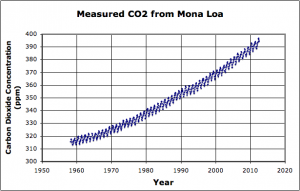This fascinating video tries to trace the evolution of the facial features of our homonid ancestors over the last 7 million years.
Category: video
Simulating the Solar System Ripped Apart
A facinating simulation of what would happen if a Sun sized object passed through the solar system.
Carbon Sequestration
Klaus Lackner from Columbia University describes one type of artificial carbon sequestration technology, and explains why it’s necessary.
Wiggle Matching: Sorting out the Global Warming Curve
To figure out if the climate is actually warming we need to extract from the global temperature curve all the wiggles caused by other things, like volcanic eruptions and El Nino/La Nina events. The resulting trend is quite striking.
I’m teaching pre-Calculus using a graphical approach, and my students’ latest project is to model the trends in the rising carbon dioxide record in a similar way. They’re matching curves (exponential, parabolic, sinusoidal) to the data and subtracting them till they get down to the background noise.

If the World were a Village of 100
A student (N.C.) sent me this neat video based on the If the World Were a Village website. I plan to show it to my environmental science class because we’ve been talking about human population recently.
A Planet Being Formed
In the early stages of the formation of a solar system, dust in the nebula around a young star is attracted to each other because of their minute gravitational attraction to each other.
In the video below, accumulation of dust and gas creates a planet, probably a gas giant, that clears a swath of the solar nebula.
Recycled Instruments: A Cello Made From Some Wood and an Oil Can
“My life would be worthless without music.”
— Young Paraguayan violinist.
The Fulton School has a wonderful music program, so I’m hoping that this video, about how Paraguayan children living in a slum on a landfill have recycled classical instruments out of the trash, resonates with some of my environmental science students.
Landfill Harmonic film teaser from Landfill Harmonic on Vimeo.
Of course, we’ve seen other instruments invented out of discarded trash. The BBC has a brief history of the steel pan, but Trinbagopan.com has an much more detail. On the other hand, I prefer my history in a musical form.
The Science of Champagne Bubbles
This nice little video combines a bit of physics, chemistry, and biology as it discusses how bubbles form in champagne: the gas is carbon dioxide; carbon dioxide forms from the fermentation of sugars by yeast — it’s a byproduct of the reaction that produces alcohol; the bubbles form at tiny flaws or bubbles in the glass (so you can put in tiny flaws to control where the bubbles form); the bubbles rise because the gas is less dense than the liquid around it; and the bubbles expand as they rise because the pressure of the liquid becomes less and less the closer to the surface you are.